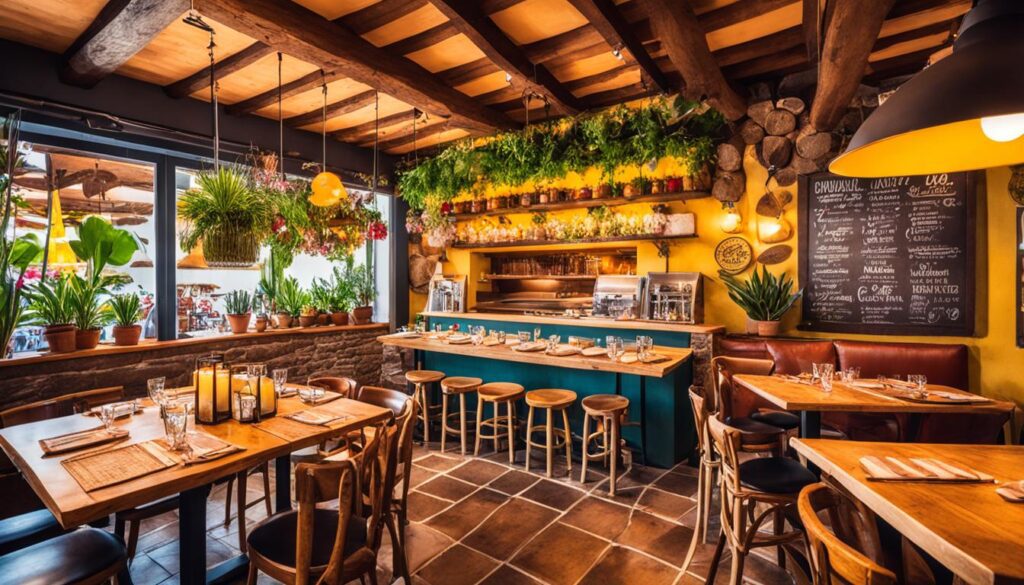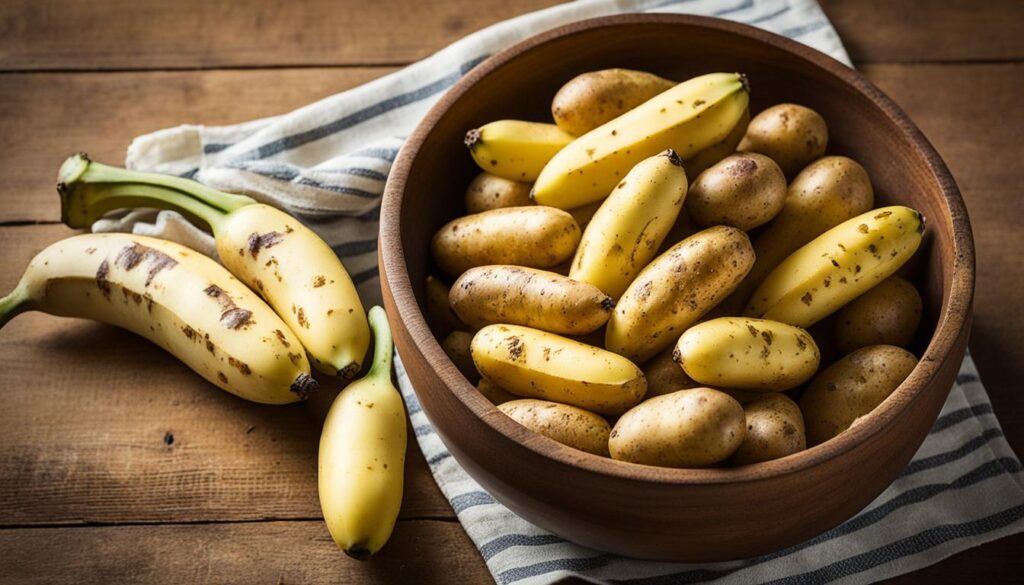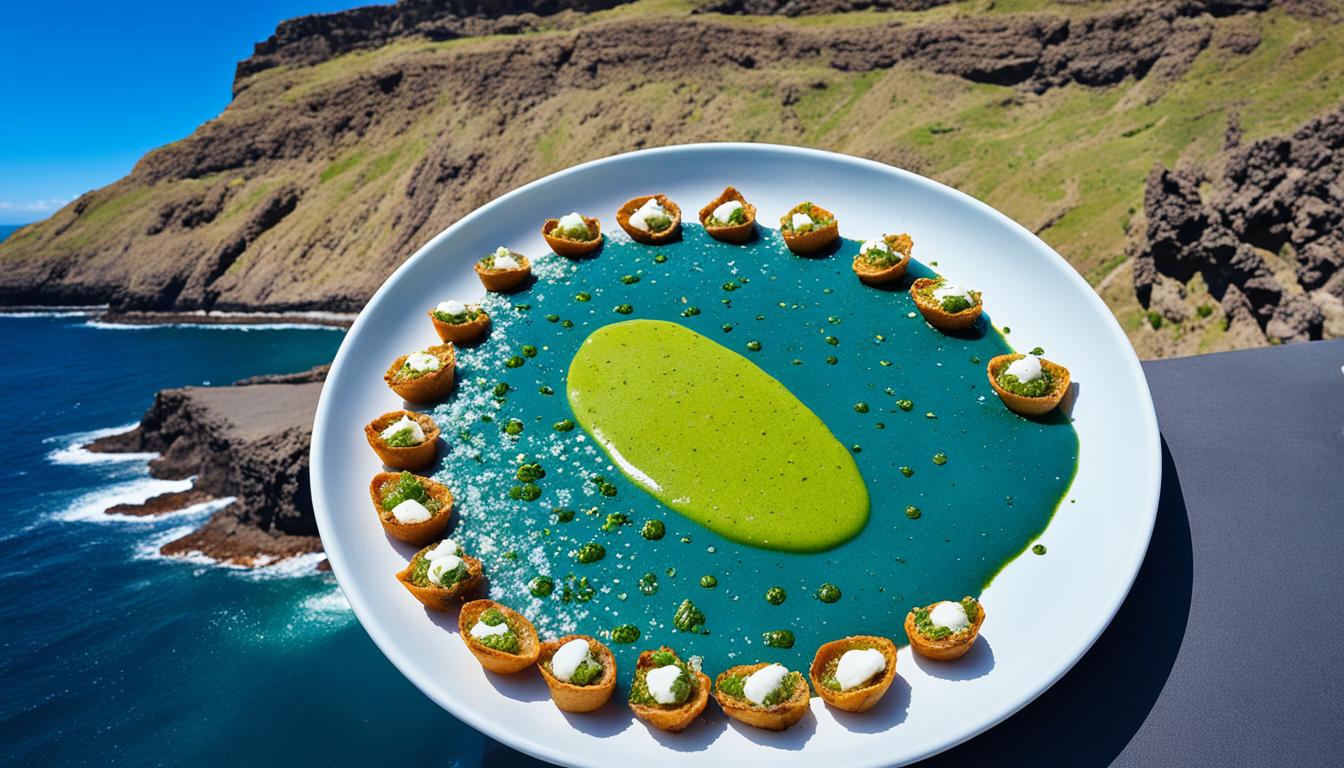The Canary Islands are a hidden gem for food lovers. They are near Africa’s west coast and have a mild climate. This mix of volcanic landscapes and diverse cultures creates a unique food scene. You’ll find dishes like papas arrugadas and gofio, made from toasted grain flour.
These dishes are just the start. The Canary Islands are also known for their protected foods. Majorero cheese and Canarian bananas are just a few examples. These foods make dining here unforgettable.
Key Takeaways
- The Canary Islands offer a unique and diverse food culture influenced by its volcanic landscapes and cultural heritage.
- Traditional dishes like papas arrugadas and gofio showcase the region’s culinary traditions and local ingredients.
- The islands are home to a variety of protected and award-winning products, including cheeses, wines, and bananas.
- Visitors can expect a rich and flavorful dining experience when exploring the local cuisine of the Canary Islands.
- The Canary Islands’ culinary heritage reflects the region’s history and diverse cultural influences.
Exploring the Unique Flavors of the Canary Islands
The Canary Islands’ cuisine is a mix of Spanish, African, and Latin American tastes. It’s shaped by the islands’ volcanic land. This mix of flavors comes from the islands’ history and local foods, making Canarian dishes special.
Volcanic Influences on Canary Islands Cuisine
The Canary Islands’ tough terrain has greatly influenced their food. The volcanic soil and climate give unique tastes to foods like papas arrugadas (wrinkled potatoes) and tomates (tomatoes). These ingredients have been key to Canarian food for a long time, with each island adding its own twist.
Cultural Fusion in Traditional Island Dishes
The Canary Islands sit at a crossroads of history, blending Spanish, African, and New World tastes. Dishes like Sancocho Canario (a fish stew) and Bienmesabe (a sweet almond treat) show off this mix of cultures.
The Canary Islands’ food offers a special taste journey. It takes diners through time and across continents. It celebrates the islands’ volcanic roots and the strong food traditions of the people.
“The Canary Islands’ cuisine is a captivating blend of Spanish, African, and Latin American influences, all shaped by the archipelago’s volcanic landscape.”
Signature Canary Islands Dishes to Try
The Canary Islands have a rich food culture. They offer traditional dishes that show off the region’s unique tastes. Papas arrugadas and gofio are two dishes that stand out.
Papas Arrugadas with Mojo Sauce
Papas arrugadas, or “wrinkled potatoes,” is a beloved Canarian dish. Small, local potatoes are cooked in salted water. This makes their skins tender and slightly wrinkled.
These potatoes are served with a tangy, spicy mojo sauce. This sauce is made of olive oil, garlic, chili peppers, and more. It perfectly matches the taste of the potatoes.
Gofio: An Ancient Canarian Staple
Gofio is a flour from toasted grains like wheat, corn, and barley. It’s been a key part of Canarian food for centuries. This versatile flour is used in many dishes, from soups to desserts.
Trying papas arrugadas or gofio gives you a taste of the Canary Islands’ unique flavors. These dishes are a great way to explore the region’s culinary traditions.
Canary Islands Local Cuisine: A Taste of Island Life
Exploring the local cuisine of the Canary Islands gives you a real taste of island life. You can enjoy meals at cozy, family-run places or try Michelin-starred dishes that mix old flavors with new techniques. The focus on fresh, local ingredients and classic recipes shows off the islands’ rich culinary heritage.
The simple papas arrugadas and the rich Ropa Vieja dish show the unique spirit of the islands. The variety of authentic Canarian recipes highlights the Canarian food culture. It’s deeply connected to the islands’ volcanic land and diverse history.
Visitors can dive into the local ingredients of the Canary Islands. This includes over 50 types of potatoes from Tenerife, the unique mojo sauces, and the famous Majorero cheese from Fuerteventura. By trying these dishes, travelers can feel the heart of the Canary Islands and connect with its lively spirit.
“Papas arrugadas con mojo is considered one of the gastronomic wonders of Spain.”
The Canary Islands’ local cuisine offers everything from the warm feel of a family-run guachinche to the luxury of a Michelin-starred place. It’s a journey that brings you closer to the island’s life and its Canary Islands’ culinary heritage.
Island Specialties: From Seafood to Cheese
The Canary Islands sit by the sea, giving them a lot of fresh, top-quality seafood. Local fishermen catch many species like parrotfish, wreckfish, and Atlantic horse mackerel. These fish add special tastes to the islands’ fresh seafood canarian dishes.
The islands are also known for their dairy products, like Majorero cheese from Fuerteventura and Flor de Guía from Gran Canaria. A favorite dish is Queso Asado con Miel. It’s grilled goat cheese with honey, a mix of sweet and savory.
Fresh Seafood Delicacies
The Canary Islands are full of fish and shellfish, making them perfect for seafood dishes. Dishes like Sancocho Canario and Pescado Seco show off the chefs’ skills. These dishes use the fresh seafood from the islands.
Queso Asado con Miel: Grilled Cheese with Honey
The Canary Islands take pride in their cheese, especially Queso Asado con Miel, or Grilled Cheese with Honey. This dish uses goat cheese grilled and topped with honey. It’s a mix of savory and sweet flavors.
| Canary Islands Cheese Specialties | Protected Designation of Origin |
|---|---|
| Majorero | Fuerteventura |
| Flor de Guía | Gran Canaria |
“The Canary Islands’ coastal location provides a rich abundance of fresh, high-quality seafood that is expertly prepared in traditional Canarian dishes.”
Sweet Endings: Desserts of the Canary Islands
The Canary Islands are known for more than just savory dishes. They have a sweet side too, with desserts that show off their unique culture. Bienmesabe, a rich almond pudding from Gran Canaria, is a standout dessert.
Bienmesabe: An Almond-Based Delight
Bienmesabe is a key part of Canarian food culture. It’s made with almonds, sugar, egg yolks, and lemon zest. This dessert has a smooth texture and tastes like honey, making it a treat for the senses.
The Dulcería Nublo de Tejeda in Gran Canaria has helped make Bienmesabe famous. They’ve increased production from 600 kilos to over 20,000 kilos a year. Now, you can find their Bienmesabe in the Canary Islands and even in Berlin, Germany.
There’s more to Canarian sweets than just Bienmesabe. You’ll find Quesillo, a custard, and Gofio ice cream, made with roasted grain flour. These are just a few of the sweet treats waiting for you.
The desserts of the Canary Islands show off their rich food culture. They mix local ingredients and old cooking methods to create tasty treats. These desserts leave a lasting impression on everyone who tries them.
Dining Experiences in the Canary Islands
Exploring the Canary Islands’ food scene is more than just eating traditional dishes. It’s about experiencing the island life through various dining settings. You can find guachinches, family-run eateries, especially in Tenerife’s wine areas.
Guachinches: Rustic Island Eateries
Guachinches are casual spots that only accept cash. They offer a menu of homemade Canarian dishes with local ingredients and wines. The friendly vibe of these places lets visitors dive deep into the island’s food culture.

Guachinches highlight the Canary Islands’ food heritage. They focus on home-cooked meals and local wines. These eateries let you see the lively food culture of the islands. They show how Canarian families have kept their recipes alive for years.
“Dining at a guachinche is like stepping into the heart of Canarian hospitality. The flavors and atmosphere transport you to a simpler time, where the focus is on enjoying good food, good company, and the essence of island life.”
Trying papas arrugadas with mojo sauce or a local wine at a guachinche is a must for a real Canarian experience. These eateries are key to understanding the islands’ food heritage. They make the Canary Islands’ food scene truly special.
Canary Islands Wine: A Volcanic Treasure
The Canary Islands are a hub for canarian wines, thanks to their unique volcanic terroir. They produce award-winning wines with ten canarian wine designations of origin across the islands. These wines range from reds to whites and rosés, known for their complex flavors and high acidity.
La Geria in Lanzarote is famous for its wines, grown in small, crescent plots of volcanic soil. This gives them a distinct taste. Wineries like Bodega La Geria, Bodegas Rubicón, and Bodegas Vulcano de Lanzarote are known worldwide for their innovative wines and commitment to canarian wine culture.
| Winery | Signature Wines | Awards |
|---|---|---|
| Bodega La Geria | Dry, semi-dry, and sweet Malvasía and Moscatel wines | Multiple international wine awards |
| Bodegas Rubicón | Rubicón, Malpei, and Amalia wine brands | Numerous international wine awards |
| Bodegas Vulcano de Lanzarote | Award-winning Malvasía wines | Recognized for quality Malvasía wines |
The Canary Islands’ canarian wine culture is rich and innovative. For centuries, grapes have been grown and made into wine here. Today, the region’s wineries amaze wine lovers with their unique, volcanic wines.
“Over 500 years, grape cultivars brought by 15th-century colonists to the Canary Islands have cross-bred and mutated to express unique characteristics not found elsewhere.”
Local Ingredients with Protected Designations
The Canary Islands are known for their top-quality, local ingredients. These have special protected designations of origin (PDO) and protected geographical indication (PGI). This shows the islands’ effort to keep their food culture real and high-quality.
Potatoes, Bananas, and More
The “old” potatoes, or papas antiguas, are a key product from the islands. They grow well in the volcanic soil. The Canarian banana is also special, being the only European PGI banana type.
There are more local treasures too. For example, Majorero cheese comes from Fuerteventura and Flor de Guía cheese from Gran Canaria. Both are protected by PDO.
| Product | Protected Designation | Region |
|---|---|---|
| Papas Antiguas (Canarian Potatoes) | PDO | Canary Islands |
| Canarian Banana | PGI | Canary Islands |
| Majorero Cheese | PDO | Fuerteventura, Canary Islands |
| Flor de Guía Cheese | PDO | Gran Canaria, Canary Islands |
These canarian local produce with protected designations show the Canary Islands’ dedication to their unique food culture. They highlight the special flavors of their canarian ingredients with protected designations.

Fusion of Flavors: Cultural Influences
The Canary Islands’ cuisine is a mix of Spanish, African, and New World tastes. This blend has shaped the traditional dishes over many years. The islands sit between Europe and the Americas, making them a meeting point for food and cooking styles. This has led to a fusion of flavors that makes Canarian cuisine special.
Ingredients like gofio and mojo sauces, along with chickpeas and vegetables in Ropa Vieja stews, show the convergence of diverse cultural influences. These elements have made the Canary Islands’ food unique and tasty. This cultural fusion takes diners on a journey through the islands’ history with every bite.
| Cultural Influence | Culinary Contribution |
|---|---|
| Spanish | Introduction of staple ingredients like olive oil, rice, and tomatoes |
| African | Influence on the use of spices, herbs, and techniques like smoking and drying |
| New World | Incorporation of New World produce like potatoes, maize, and chili peppers |
The canarian food culture shows the islands’ rich history and the people’s skill in blending different tastes. It offers a unique gastronomic experience found only in the Canary Islands.
“The Canary Islands’ cuisine is a delicious reflection of the region’s cultural diversity, where flavors from around the world converge to create a truly exceptional dining experience.”
Authentic Canarian Recipes for Home Cooks
Home cooks can dive into the flavors of the Canary Islands by making traditional dishes at home. They can try making papas arrugadas with mojo sauce, gofio-based dishes, and Bienmesabe. These recipes let you taste the islands’ culinary heritage right in your kitchen.
Using authentic Canarian ingredients is key to bringing the islands’ unique tastes to your table. Whether you find them locally or through specialty stores, these ingredients will help you recreate the Canary Islands’ cuisine at home.
Recreating Island Flavors at Home
Papas arrugadas, or wrinkled potatoes, are a staple in Canarian cuisine. To make them, boil small, waxy potatoes in salted water until they’re tender. Then, dry them out to get that wrinkled look. Serve them with a mojo sauce, like mojo picón or mojo verde, for that true Canarian flavor.
For a filling meal, try escaldón de gofio. This dish uses gofio, a roasted flour that’s a key ingredient in Canarian cooking. You can add it to stews, soups, or even desserts for a nutty flavor.
No visit to the Canary Islands is complete without trying their desserts. Bienmesabe, a sweet almond treat, is a must-try. It’s made with ground almonds, honey, and cinnamon, offering a taste of the islands’ sweetness.
These authentic Canarian recipes let home cooks explore the vibrant flavors of the Canary Islands. Whether you’re making papas arrugadas, gofio-based dishes, or Bienmesabe, you’ll enjoy the taste of the islands in your own kitchen.
Conclusion: Savoring the Essence of the Canary Islands
The Canary Islands’ local cuisine shows off the archipelago’s rich history, stunning nature, and diverse culture. Traditional dishes have flavors shaped by the islands’ volcanic soil. The Canarian culinary heritage gives visitors a deep taste of island life.
Enjoying papas arrugadas, tasting the almond flavor of Bienmesabe, or trying different foods around the islands, the authentic Canarian food experience lets travelers enjoy the islands’ true flavors. Each bite tells a story of this enchanting Spanish place.
The Canary Islands’ food scene is a celebration of their traditions. It shows the islands’ dedication to keeping their unique food culture alive. Visitors will find themselves immersed in the islands’ flavors, stories, and hospitality. This makes the Canary Islands a special place to explore.

